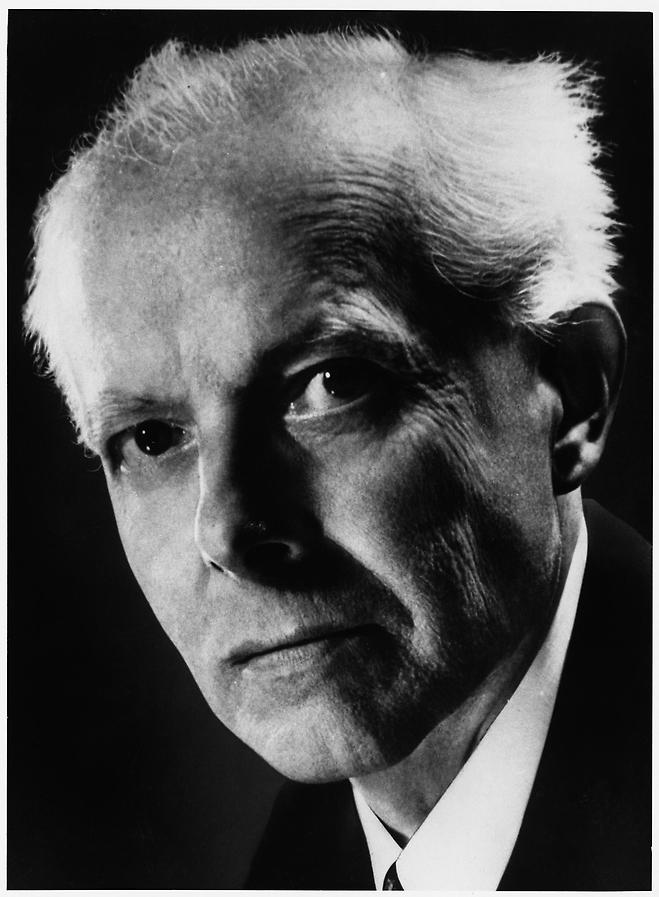Béla Bartók
Divertimento, for string orchestra, Sz. 113, BB. 118
이 곡은 바젤 챔버오케스트라의 창립자이자 지휘자 파울 자허의 의뢰로 1939년 작곡되었으며, 바르토크가 헝가리를 떠나 미국으로 망명하기 직전에 완성되었다.
절망의 시대에 만난 든든한 후원자
바르토크가 이 작품을 의뢰받았던 시기, 유럽 전역을 공포로 몰아넣으며 광기를 더해가던 나치정권에 의해 헝가리 역시 정치적인 불안으로 소용돌이치고 있었다. 특히 반나치주의자 바르토크는 독일에서의 콘서트 활동과 출판이 불가능하게 되었다. 위기를 느낀 바르토크는 1938년부터 자신이 가장 아끼는 작품들을 속속 해외로 반출하면서 망명을 준비했고, 급기야 1940년 아내와 함께 조국을 떠나 뉴욕으로 향한다.
이처럼 공포스러운 위기에 직면해 있던 바르토크에게 파울 자허(Paul Sacher, 1906~1999)의 존재는 구원자에 가까웠다. 지휘자 파울 자허는 20세기의 대표적인 작곡가들에게 작품을 의뢰하여 수많은 현대음악을 연주한 선구자였고, 특히 바르토크의 작품세계에 흥미를 가졌다. 이미 1936년에 바르토크의 〈현과 타악기, 첼레스타를 위한 음악〉을 연주했던 자허는 1939년 이전 작품보다는 덜 난해하고 좀 더 고전적인 작품을 의뢰했다. 또한 바르토크가 작곡에 매진할 수 있도록 스위스의 자신의 별장을 제공했고, 바르토크는 15일 만에 작품을 완성할 수 있었다. 그는 아들에게 쓴 편지에서 “마치 후원자에게 초대받은 옛 시대의 음악가가 된 느낌이다”라며 자허의 배려에 감사했다.
바르토크는 겨우 15일 만에 이 작품을 완성했지만, 여느 작품과 다름없이 특유의 정확성을 보여주고 있다. 그는 주법이나 다이내믹, 템포 등에 대한 지시사항을 정확하고 꼼꼼하게 명기하였다. 1악장의 첫 24마디에서는 두 차례 알라르간도(allargando, 점점 느려지면서 점점 크게)를 지시하여 리듬과 선율을 강조하였다. 또한 1악장의 솔로 부분을 대부분 피아노나 메조피아노로 지시하여 포르테의 투티와 극적인 대비를 이루도록 연출했다. 이러한 음향적 대비는 시종일관 생기 넘치는 흐름을 만들어낸다. 74마디의 짧은 2악장에서도 14차례나 템포를 변경하면서 리듬의 다양성을 구가하였다.
바르토크는 자허가 원한 대로 보다 고전적인 양식의 음악을 전개한다. ‘디베르티멘토’라는 장르 속에서 텍스처의 다양성을 통해 솔로와 투티의 음향을 대비시킴으로써 바로크 시대의 콘체르토 그로소를 연상시키는 음향을 펼친다. 모방기법이나 푸가토 등 다양한 대위기법 역시 옛 시대의 음악을 연상시킨다. 그럼에도 바르토크 특유의 실험적 리듬과 현대적 조성감각이 예리하게 드러나 있는 독특한 작품이다.
악곡 구성
1악장 ‘알레그로 논 트로포’
왈츠풍의 1악장은 투티가 연주하는 3성 푸가의 텍스처 속에서 바이올린이 레치타티보풍의 독주 카덴차를 연주하며 시작된다. 이 독주선율은 리듬이나 화성에서 집시음악의 영향을 보여준다. 다양한 선법과 비전통적 음계를 사용하고 있으며 리듬 역시 비대칭적 악센트와 당김음으로 집시음악의 느낌을 준다. 대칭적 박자와 비대칭적 박자가 번갈아 사용되어 모호한 느낌을 주지만, 형식적으로는 전통적인 소나타 형식을 따르고 있다. 오케스트레이션은 바로크 시대 음악에 대한 바르토크의 오마주를 담고 있다. 솔로 그룹과 투티는 텍스처와 음향에서 뚜렷한 대비를 이룸으로써 바로크 시대 콘체르토 그로소를 연상시킨다. 화성적 어법은 1악장 전반에 걸쳐 매우 반음계적이고 선법적이지만, 바로크 음악의 화성어법을 모방한 부분도 있다.
2악장 ‘몰토 아다지오’
느리고 어두운 느낌의 2악장은 바르토크 특유의 ‘밤의 음악’ 양식으로 전개된다. 신고전주의적 경향을 드러내듯 전통적인 3부분 형식으로 이루어져 있지만, 화성이나 선율은 거의 무조성에 가까운 실험적인 어법을 보여준다. 3개의 주제선율이 모방기법으로 전개되면서 불협화음을 만들어내고, 이 불길하고 어두운 음향은 다이내믹의 날카로운 대비로 더욱 강조된다. 바르토크는 더블스톱과 하모닉스를 자주 사용하여 연주자들에게 고난도의 기교를 요구한다.
3악장 ‘알레그로 아사이’
3악장은 빠른 춤곡풍의 론도로, 2악장에 비해 보다 협화음적이고 선법적이어서 고전적인 발랄함을 연출한다. 솔로와 투티가 모방기법으로 전개된다.
[글-이은진 /출처-클래식 백과]
- Composer: Béla Viktor János Bartók (25 March 1881 -- 26 September 1945)
- Orchestra: RIAS Symphony Orchestra
- Conductor: Ferenc Fricsay
- Year of recording: 1956
Divertimento for String Orchestra Sz.113, BB.118 is a three-movement work, scored for full orchestral strings, written in 1939.
00:00 - I. Allegro non troppo
08:50 - II. Molto Adagio
17:44 - III. Allegro assai
This work marks the end of Bartok's European career. It was composed on commission from Paul Sacher, the pioneering conductor who commissioned so much fine music for his string orchestra in Basle, Switzerland. Bartok was then already planning to move to the United States to escape both the gathering war clouds of Europe and the Nazi sympathizing regime of his native Hungary. He had already sent his manuscripts and papers to London, but remained at home because of the terminal illness of his mother. While taking a break from all this he visited Sacher in Switzerland and while there composed this substantial (nearly 25 minute) work in 15 days. His mother died in December; Bartok finished up his personal affairs in Europe, giving his farewell Budapest appearance in October 1940. Meanwhile, the Divertimento had been successfully premiered in June in Basel, Switzerland.
Audiences were struck with a new clarity and classical approach in Bartok's music, as well as by his returning to a much clearer tonal feeling. This consolidated a trend which actually began a few years earlier. Longer, more attractive melodies (almost always in folk-character) reappear after a decade and a half in which Bartok's music was famous for its harsh sounds, uncompromisingly dissonant harmonies, and tight, motive-driven formal procedures. In this period it is easy to find (and hear) distinct tonality. The work's three movements, for instance, are in F Major, a modal scale based on D, and again in F. Bartok's use of solo strings against the large string group (particularly in the first movement) recalls the concerto grosso form.
- The opening movement is a suave and gracefully dance-like "Allegro non troppo," full of attractive melodies, but also making highly intellectual use of canons, inversions, and other such devices.
- The Second movement is a remarkable example of Bartok's "Night Music, " including a frightening central section which seems to suggest some terror of the night.
- The third movement is even more playful than the first, a bit earthier, and somewhat faster. It even spoofs Bartok's tendency to drop into canons and fugues: what appears to be a full-fledged fugato section dissolves soon after it starts, the music laughs at itself, and comes to a whirling conclusion.[유튜브]
'♣ 음악 감상실 ♣ > [로망스, 야상곡]' 카테고리의 다른 글
| Ignaz Brüll- Serenade 모음 (0) | 2018.09.22 |
|---|---|
| Johann Ludwig Böhner: Serenade in F Major, Op. 9 (0) | 2018.09.06 |
| Josef Suk - Serenade in E flat Major op. 6 (0) | 2017.09.09 |
| Leonhard von Call - Sérénade Op.66 /Serenade for Flute & Guitar, Op. 132 (0) | 2017.07.19 |
| 실내악 [Chamber Music] 모음 (0) | 2017.07.19 |
